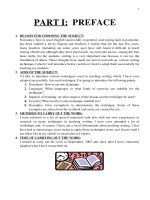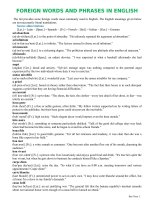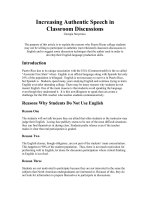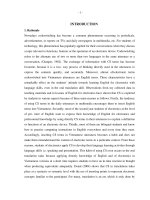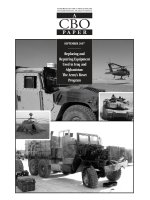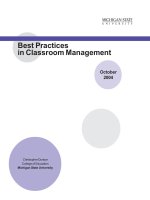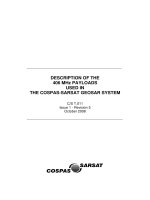Writing techniques used in classroom
Bạn đang xem bản rút gọn của tài liệu. Xem và tải ngay bản đầy đủ của tài liệu tại đây (127.75 KB, 19 trang )
PART I: PREFACE
1. REASON FOR CHOOSING THE SUBJECT :
Nowadays, how to teach English successfully in general, and writing skill in particular,
has been studied a lot by experts and teachers. I realize that for the last few years,
many teachers (including me some years ago) have still found it difficult to teach
writing effectively although they have tried much. As everyone knows, among the four
basic skills, for the students, writing is a very important one because it can lay the
foundation of others. These thoughts have made me start to research on various writing
techniques (which I will introduce below) and have tried to adapt them successfully for
teaching my students.
2. AIMS OF THE SUBJECT :
I’d like to introduce various techniques used in teaching writing which I have ever
adapted successfully. For each technique, I’m going to introduce the following points:
1. Procedure: How to use the technique.
2. Language: What languages or what kinds of exercise are suitable for the
technique?
3. Stage(s) of teaching: At what stage(s) of the lesson can the technique be used?
4. Level(s): What level(s) is the technique suitable for?
5. Examples: Give example(s) to demonstrate the technique. Some of these
examples are taken from the textbook and some are created by me.
3. METHODS TO CARRY OUT THE WORK :
I have referred to a lot of special materials (and also with my own experience) to
research on many techniques in teaching writing. I have ever attended a lot of
workshops and, of course, I have got a lot of information about teaching writing. I also
have had to spend many years trying to apply these techniques in my real classes until I
see what I do in my classes is successful as I expect.
4. TIME OF CARRYING OUT THE WORK :
I started to carry out the work in September, 2002 and since then I have constantly
adapted what I have researched on.
1
PART II: CONTENT
In order to motivate the students as well as to teach writing effectively, we should use different
techniques with different levels of language according to the students’ ability. I’m going to
present a variety of techniques from the simplest techniques to the most difficult ones.
I. TECHNIQUES USED TO TEACH : WRITING SENTENCES:
In this part, I’m going to describe the techniques used to teach the students to write
sentences separately.
1. Put the words in order:
a. Procedures:
The teacher gives the students sentences with words in the wrong order. The teacher
asks the students to put them in the correct order to make complete sentences.
b. Language: This technique is especially helpful in practising grammatical structures
in the textbooks.
c. Stages of teaching: We can use this technique at the stage of controlled practice or
post-practice or in testing the students.
d. Levels: All levels.
e. Examples: Here are some examples:
1. interesting / to find / country / we / live / it / in / the
→We find it interesting to live in the country.
2. travel / world / wish / around / I / the / I / could
→I wish I could travel around the world.
3. left / used / on / they / not / the / driving / are / to
→They are not used to driving on the left.
* The teacher can make it easier for the students if he gives the first word
beginning with a capital letter:
Example:
last / have / up / He / stayed / night / must / late
→ He must have stayed up late last night.
2. Answer the questions:
a. Procedures:
-The teacher gives the students a text or a dialogue to read first
-The teacher puts the questions about the text or the dialogue on the
blackboard. (or just reads the questions after the students read the text or the
dialogue)
-The students read the text or the dialogue (or just listen to the teacher) and
write answers to the questions.
b. Language: This technique is mainly used for dealing with a text or a dialogue.
c. Stages of teaching: We use this technique at the stage of While-Reading.
d. Levels: We can use this technique for all levels. But it is best for the beginners
because they are supposed to practise writing complete sentences at first. And,
2
of course, WH-questions are the most suitable.
e. Examples: Here are 2 examples:
1. Carol Stuard is a good student. She is studying chemistry. She can play the
piano and the guitar very well. She is a very good cook and swimmer. She
speaks Russian and French perfectly. She is beautiful, too.
-The teacher gives questions:
a) What is Carol Stuard doing?
b) What can she play?
c) What languages does she speak? …
-The students are supposed to write the full answers like this:
a) She is studying chemistry.
b) She can play the piano and the guitar very well.
c) She speaks Russian and French.
2. BEFORE THE LECTURE
Student A: Do you live in the hostel?
B: No, I don’t. I live in a flat in Watford.
A: How far is it to college?
B: It’s about 5 miles.
A: How do you get here?
B: I usually go by train, sometimes I cycle.
A: Really? Do you ever go by bus?
B: No, never. It’s very slow.
-The Teacher gives questions:
a) Where does student B live?
b) How does student B usually go to college?
-The students are supposed to write the full answers like this:
a) The student B lives in a flat in Watford.
b) The student B usually goes to college by train.
3. Complete the sentences:
a. Procedures: The teacher gives the students sentences with words missing.
They must put the correct words with the correct form in the empty spaces:
b. Language: This technique can be used for various language of practice, such
as prepositions, articles, lexical words, grammatical structures, etc.
c. Stages of teaching: We can use this technique at the stage of cotrolled
practice or post-practice.
d. Levels: All levels.
e. Examples: Here are some kinds of exercise:
1. A few words can fill all the empty spaces. This kinds of exercise is used to
practise a/an or the; some, any etc.; prepositions etc. The missing words can
be given at the beginning of the exercise:
* Example 1: Put SOME or ANY in the spaces in the following sentences:
a. Do you want ………………………… food here?
b. There are ………………………………… books on the table.
c. At the moment, he doesn’t have …………………………… money.
3
d. Have you got ……………………………………… eggs here?
e. You haven’t got ………………………………… new clothes, but I have …………………………………
* Example 2: Fill in each gap with SO, SUCH, SO MANY, SO MUCH:
a. It was …………………………a hot day yesterday that we went for a walk for 2 hours.
b. She has ……………………money that she can buy everything she wants.
c. That singer has ……………………………a agreeable voice.
d. There are ……………………stars in the sky that we can’t count them.
e. The book is …………………………thick that I can’t finish it in two hours.
f. Why have you got …………………………… furniture?
g. I have ………………………………work to do that I can’t go to bed early.
h. It is ……………………………a difficult question that no one can answer it.
i. Doctor Simon has …………………………patients that he is always busy.
j. The boy is ………………………………intelligent that everyone admires him.
2. Each missing word is given but the learners must use the correct form. This
type of exercise is used to practise tense, verb form, singular / plural, word
form etc.
* Example 1: Give the correct form (singular / plural) of the words in brackets:
a. There is a (boy) ……………………………… in the room.
b. My (pen) ……………………………… are on the table.
c. Are there 40 (pupil) ………………………………………… in your classroom?
* Example 2: Give the correct tense of the verbs in brackets:
a. When I (arrive) ………………… at the station yesterday, the train (go) ……………………
b. It began to rain while we (play) ………………………………… in the garden.
c. She always (buy) ………… fish for meal whenever she (go) ……………to market.
d. What ………… you (do) …………… when I (come) …………… to your house tomorrow?
e. I (not/ hear) ……………………… of him since I (meet) ……………………… him 5 years ago.
f. He thinks he (become) …………………… a doctor when he (grow) ……………………… up.
* Example 3: Give the correct form of the words in brackets:
a. His hard study (able) …………………………… him to become a headmaster.
b. We’ll (rich) …………………… our vocabulary if we read English books every day.
c. Vietnam has become a/an (depend) ……………… country since April 30
th
, 1975.
d. I wish you could hear some of the (speak) ……………………… there.
e. Money as well as fame can’t bring you (happy) ………………………………………
f. Don’t be so (patient) …………………… We have been waiting only a few minutes.
g. Her parents (courage) ………………………… her to become a doctor.
* Example 4: Give the correct verb form:
a. Ann likes (cook) ……………………………… but hates (wash) ………………………………up.
b. When you see Tom, remember (give) ……………………………him my regards.
c. My watch keeps (stop) …………………………………
d. do you plan (go) ………………… out or (stay) ………………… at home this weekend?
e. They postponed (build) …………………an elementary school for lack of finance.
f. Tom refused (give) ………………………me his address.
3. The teacher gives a list of sentences with gaps, and a list of words. The
teacher asks the students to fill in each gap. This exercise becomes more
4
difficult if the teacher gives more words than gaps.
* Example 1: Fill in each gap with a suitable word from the list given:
astronaut weightless foundation launched solar
discovery gravity champion escaped orbiting
a. The ………………………………of X- rays changed the history of medicine.
b. Neil Armstrong was the first ……………………………… who stepped on the moon.
c. Astronaut ……………………………the earth in space capsules are …………………………………
d. ………………………………… is the pull of the earth.
e. The earth and the moon belong to the ……………………………system.
f. The United States ………………………………its first weather satellite in 1959.
g. A …………………high jumper can jump only seven and a half feet off the ground.
h. The builders have only just started to lay the …………………… of the new school.
i. A lion …………………………from its cage at Bristol zoo last night.
* Example 2: Fill in each gap with a suitable word/phrase from the list given
(there are more words than the gaps):
gesture alone quit shake hands welcome partner smokers
make a point dance relaxed eat out introduced starts
a. “Home ………………………” has been a very popular film in our neighborhood.
b. When I came to Vietnam, he ……………………………me to his boss.
c. In this restaurant, there is a section reserved for ………………………………
d. We always ……………………… of trying to make our guests feel comfortable.
e. The Vietnamese women rarely ……………when they are introduced to
someone.
f. Jane is a quiet girl. She seldom ……………………a conversation at a social
meeting.
g. My father has coughed for a few days and he has decided to …………smoking.
h. We were very impressed by the nice …………………………………of his hostess.
i. We like the ……………………………atmosphere of our home in the evening.
j. I appreciate his dancing ……………………………at the party last night.
4. The teacher gives a list of sentences with gaps but doesn’t give the missing
words so the students must supply them themselves. A pattern can be given
to help the students.
* Example: Subject + verb + object +To-infinitive…
I allowed them to use my house.
a. My parents advise ………………………………………………………………
b. We recommend ……………………………………………………………………
c. He permits ………………………………………………………………………………
5. The teacher gives a list sentences with gaps. At each gap there is a choice of
4 words. The students must choose the best word:
* Example:
1. Either you or he ……………………… wrong.
a. are b. were c. have been d. is
2. The doctor with the nurses ……………………exhausted after the operation.
a. were b. was c. have been d. are being
5
3. Each boy and each girl …………………………… has a book .
a. are having b. have had c. have d. has
4. Writing a lot of letters ……………………………… her tired.
a. makes b. make c. have made d. are making
5. John as well as Mary ……………………………………… very kind.
a. were b. are c. is d. have been
4. Replace the words:
a. Procedures: The teacher gives the students some sentences and asks them to replace
some of the words in the sentences with other words:
b. Language: This technique helps practise using vocabulary (synonyms)
c. Stages of teaching: This technique can be used at the stage of post-practice
(after presenting new words or a structure or after reading a text).
d. Levels: All levels.
e. Examples: Here are some kinds of exercises for this technique:
1.The teacher gives some sentences with some underlined words and a list of
words which are used to replace the underlined words in the sentences. This
exercise is more difficult if there are more words in the list than the underlined
words in the sentences:
* Example:
grateful stay out of pick me up accept disappointed
a. He has promised to come and take me along at 6 p.m.
b. I’m very happy to get your invitation to your party next week.
c. When you have flu, you should keep away from your friends at school.
d. His parents were not pleased with his results.
e. We are very thankful to you all for your help.
2.The words which should be replaced are underlined. The students must find
the new words by themselves:
* Example:
a. English is not the private possession of any nation.
b. In this class girls are greater in number than boys.
c. In Malaysia, lecturers us English to speak to their students.
d. They were concerned with the riot last year.
e. English provides the ready way to world scholarship and world trade.
f. There are a lot of countries speaking English as their first language.
g. When the plane comes near the airport, the pilots use English to ask for
landing instructions.
h. The pilot managed to put the plane down safely.
i. Last week I was asked if I would like to go to a dancing hall.
j. I was totally tired and worn out after the football match.
k. I want you to come here without any delay.
l. He was very sorry for the way they behaved.
m. Many people told beforehand that Kohn F. Kennedy would be assassinated
n. Two cars drove into one another at a crossroads this morning.
o. “I am frightened,” she said in a low voice.
6
3. The words which should be replaced are underlined. The new words for each
sentence are given at the end of the sentence. The students must put them in
the correct place:
* Example:
a. I usually go by train. (every day)
b. He goes to school with his girlfriend every morning. ( always)
c. I play volleyball once or twice a month. (sometimes)
d. I don’t smoke at all. (never)
4. The words which should be replaced are underlined. Under the sentence, there
is a list of words. Some of these words can replace the underlined word. Some
of them cannot because of the grammar. The students must circle the words
which can replace the underlined word:
* Example:
a. They encouraged me to study harder.
( told advised allowed let agreed stopped)
b. The police don’t allow you to park here.
( ask permit show help know)
c. They chose him to be manager.
(selected picked out wanted made preferred)
5.Change the sentence:
a. Procedures: The teacher gives the students some sentences and asks them to
rewrite them making certain changes.
b. Language: This technique is usually used to practise a lot of grammatical
structures in the textbook.
c. Stages of teaching: This technique can be used at the stages of controlled-
practice and post practice.
d. Levels: All levels.
e. Examples: Here are some examples:
* Example 1: Rewrite the following sentences using the simple past tense:
1.He likes drinking tea in the morning.
2.They don’t go to school.
3.Do you want that shirt?
4.I am at home.
5.Are you a teacher?
6.He isn’t a good pupil.
* Example 2: Rewrite the following sentences, beginning with the word(s) given,
but don’t change the meaning:
1.I don’t write to him because I don’t know his address.
If …………………………………………………………………………………………………………………………………………………………
2.Listen to me carefully or you don’t understand the instructions.
If …………………………………………………………………………………………………………………………………………………………
3.I came home late last night, so I didn’t meet my old friends.
If ………………………………………………………………………………………………………………………………………………………
4.Unless you work hard, you’ll fail the exams.
7
